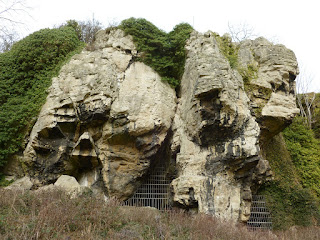 |
| Creswell Crags Cave, Derbyshire, UK. Image Credit hedgeduid.com |
It is possible that early humans visited the Crags with the seasons in order to track herds of reindeer and horse. This was due to the herds being a vital source of food for early humans. They would have then returned to the South as the winter arrived. A stream ran nearby to the crags, water is a vital resource for humans and the herds of animals, providing a source of prey. Caves and rock overhangs would have sheltered early humans from the elements. But living in caves would have been dangerous as lions and bears also used caves as shelter. It is possible that the humans would have settled on top of the gorge's cliffs away from predators and the insects near the stream. The crags could have also been a meeting place, where information was shared and products traded.
The settlements could be improved with simple amenities. Large rocks and post holes are found at the crags, this is evidence of primitive windbreaks being built from skins and wooden posts. Fire would have also been used for warmth and cooking. Fire also scares off animals.
The caves are south facing, this allows for more sunlight to enter the caves. We find larger archaeological deposits in south facing caves because of this reason.
 |
| Mammoth cave painting, Roufignac, France. Image credit mammoth.psu.edu |
Many caves are found with early paintings. The purpose of cave paintings is not known. They are not believed to be decoration as the caves don’t show signs of long term habitation. Paintings are similar around the world they show mostly animals. Humans typically appear as hand stencils that were made by blowing pigment on a hand held on the wall. There are a number of theories behind the paintings; Henri Breuil interpreted the paintings as being hunting magic; meant to increase the number of animals present in the area to make hunting better. David Lewis-Williams developed the theory that suggests that the paintings were made by shamans. The shaman would enter the cave and enter a trance, then paint images of their visions.
No comments:
Post a Comment